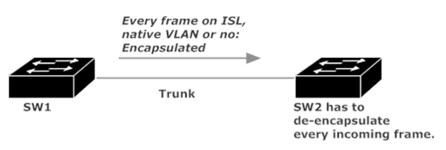CCNA 200-301 Bulldog Practice Exam: Switch Stuff!
This CCNA 200-301 Bulldog Practice Exam will test you on trunking protocols, switch configs, and more. Let’s get started… and when you’re done here, you really should join me on Twitter and YouTube!
Chris Bryant’s CCNA YouTube Channel
Question 1:
Of ISL and IEEE 802.1q, which tags every single frame that goes across a trunk?
A. Both of them.
B. ISL only.
C. IEEE 802.1q only.
D. Neither of them.
Question 2:
Of ISL and IEEE 802.1q, which is considered the industry standard trunking protocol?
Question 3:
Disabling which of the following commands on a Cisco switch is considered a security vulnerability?
A. logging synchronous
B. hostname
C. exec-timeout
D. telnet
Question 4:
What’s the native VLAN number?
A. 0
B. 255
C. 100
D. 1000
E. 1
Question 5:
Of the two major trunking protocols, which is considered to have the lowest overhead?
A. ISL
B. VTP
C. IEEE 802.1q
D. CDP
The answers follow these links to other CCNA Practice Exams and CCNA Command References here on the site!
CCNA Practice Exam: OSPF Fundamentals
CCNA Command Reference: service timestamps
CCNA Command References: ip domain-lookup
Answer 1: B. One of the drawbacks to ISL is that it will encapsulate every single frame that goes across the trunk, regardless of whether the frame is destined for the native VLAN. Actually, ISL doesn’t even know what the native VLAN is.

Answer 2: IEEE 802.1q is the industry standard trunking protocol, a fancy way of saying that it’s capable of running on Cisco and non-Cisco switches alike. The other main trunking protocol, ISL, is Cisco-proprietary, a fancy way of saying it’s only capable of running on Cisco switches.
Important note — just because ISL can run on Cisco switches doesn’t mean every Cisco switch comes out of the box with the capability of running ISL. Many Cisco switches only run IEEE 802.1q (“dot1q”).
Answer 3: C, exec-timeout. Setting this timer to zero minutes and zero seconds effectively disables the timeout, and while that’s fine for a lab environment, you don’t want to set this command to all zeroes in a production network.
Answer 4: E. The native VLAN is VLAN 1. By default, all ports on a Cisco switch belong to this VLAN.
Answer 5: C. IEEE 802.1q, usually referred to as simply “dot1q”, has less overhead than the other major trunking protocol, ISL. Why? ISL encapsulates every single frame before sending it across the trunk. Dot1q adds only a small Ethernet tag (4 bytes, that is) into a frame before transmission, and if that frame belongs to the native VLAN, dot1q won’t even insert that small value!

That’s it for this CCNA Bulldog Practice Exam! Click that link for dozens of additional CCNA exams, and I’ll see you here (and on Twitter and YouTube) tomorrow!




